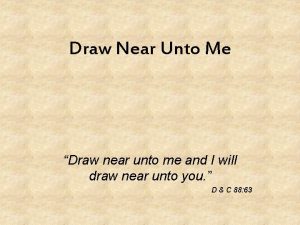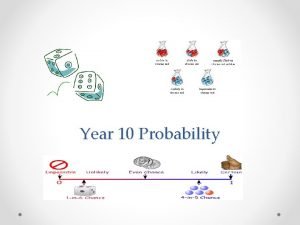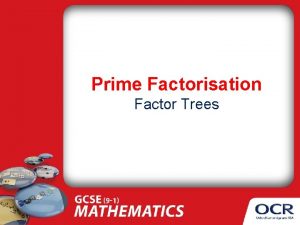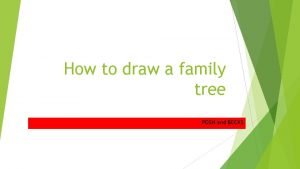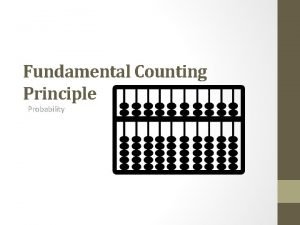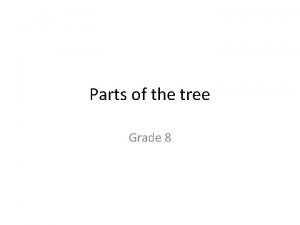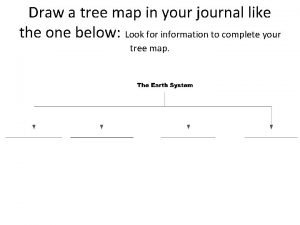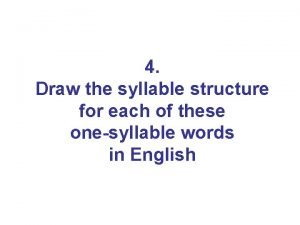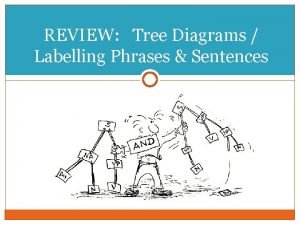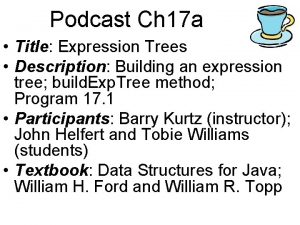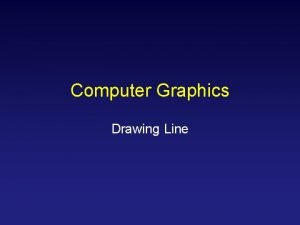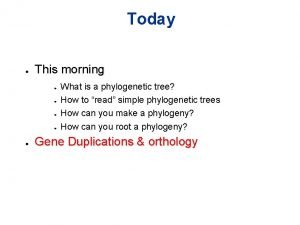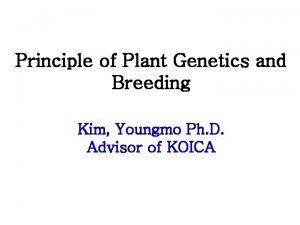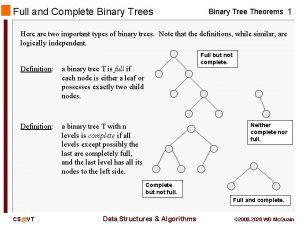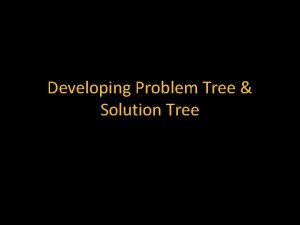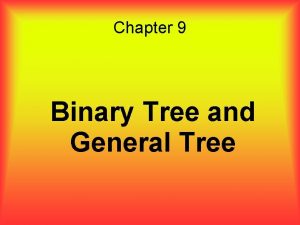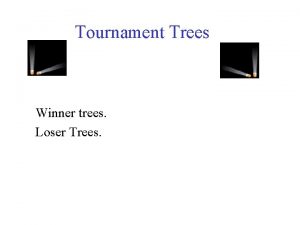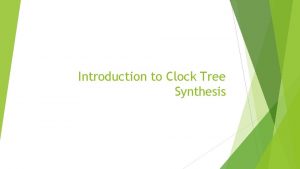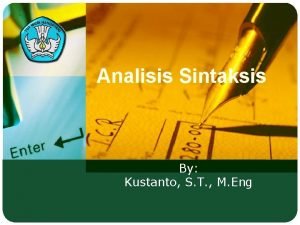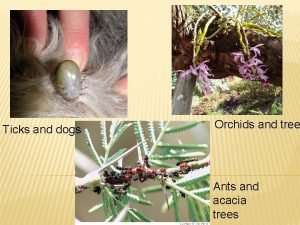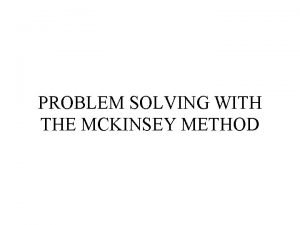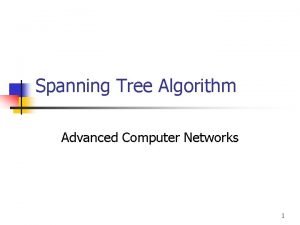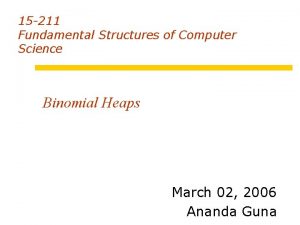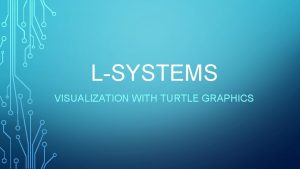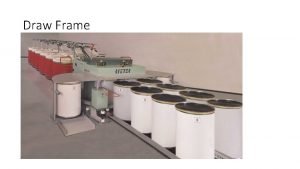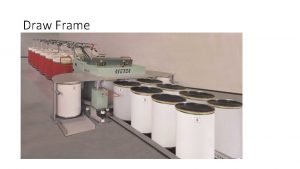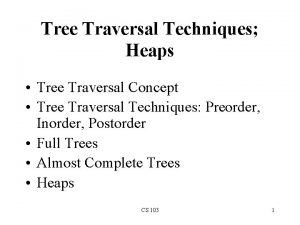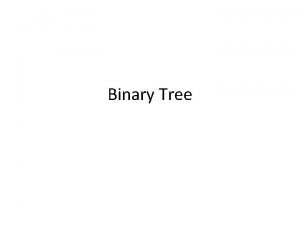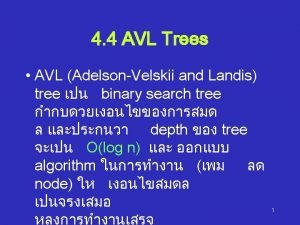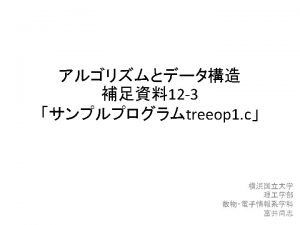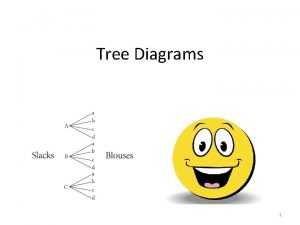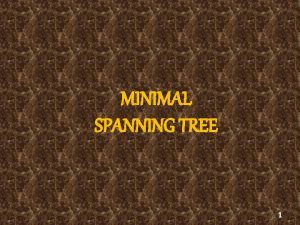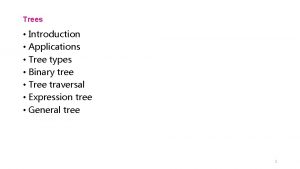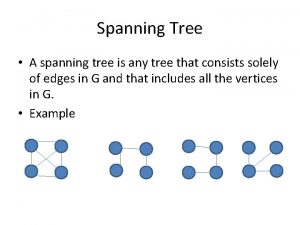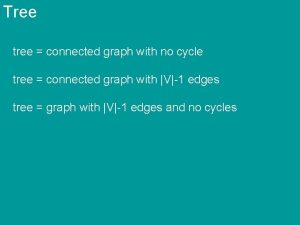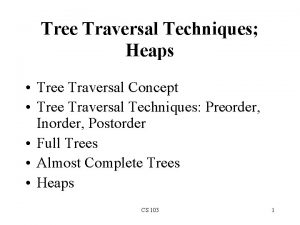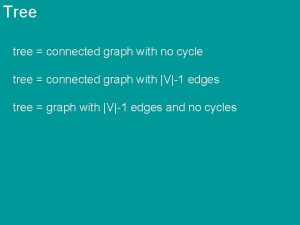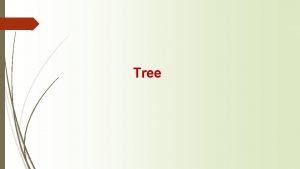How to Draw a Tree LSystems in Computer










![Branching L-Systems: Add two characters to alphabet: [ and ] Interpret [ to mean Branching L-Systems: Add two characters to alphabet: [ and ] Interpret [ to mean](https://slidetodoc.com/presentation_image_h/1eee7f7773fc3ba6d6a2cec7687a9bf8/image-11.jpg)



![Parametric L-Systems: Axiom: A(3) A(x) : x<5 B(y) : * B(x+1)A(x*r) F(y)[+F(y/2)][-F(y/2)] Interpretation: F(x) Parametric L-Systems: Axiom: A(3) A(x) : x<5 B(y) : * B(x+1)A(x*r) F(y)[+F(y/2)][-F(y/2)] Interpretation: F(x)](https://slidetodoc.com/presentation_image_h/1eee7f7773fc3ba6d6a2cec7687a9bf8/image-15.jpg)



















- Slides: 34

How to Draw a Tree L-Systems in Computer Graphics Steven Janke

Natural Trees

Tree Shapes

Euclidean Geometry Approach

Self-Similarity of Organic Forms

Computation = Processing Strings Input: aababccacabb Computer Output: adfeeefg Interpretation: 001100101011 0011 2 + 3 00110101 5

L-System (Named after biologist Astrid Lindemayer in 1970’s) § Alphabet of characters. § First string called the axiom. § Set of productions showing how to replace characters. § All appropriate productions applied at once. Example: Alphabet: {a, b} Axiom: ab Productions: a bab , Derivation: ab baba b a abab

Languages: L(G) = set of strings that can be derived from the system G. Example 1: Axiom: ab ab aab Productions: a aaab a b aaaab ab L(G) = { an b | n > 0 } Example 2: Axiom: a a b L(G) = ? Productions: a ab b abbab bababbab

Languages: L(G) = set of strings that can be derived from the system G. Example 1: Axiom: ab ab aab Productions: a aaab a b aaaab ab L(G) = { an b | n > 0 } Example 2: Axiom: a a b Productions: a ab b abbab L(G) = { s | s 0 = a, s 1 = b, sn = sn-2 sn-1 } b ab bababbab

Simple L-System: Alphabet: { F, +, - } Axiom: F-F-F-F Production: F FF Turtle Interpretation: F means draw a line segment in current direction. + means turn left. - means turn right. Start Initial direction F-F-F-F means: Delta = 90 degrees
![Branching LSystems Add two characters to alphabet and Interpret to mean Branching L-Systems: Add two characters to alphabet: [ and ] Interpret [ to mean](https://slidetodoc.com/presentation_image_h/1eee7f7773fc3ba6d6a2cec7687a9bf8/image-11.jpg)
Branching L-Systems: Add two characters to alphabet: [ and ] Interpret [ to mean “start branch”. Interpret ] to mean “end branch”. F[+F][-F] means: Initial Direction Start Delta = 45 degrees

Turtles in 3 D: Left Head Up + = left turn - = right turn & = pitch down ^ = pitch up / = roll right = roll left

Growth Functions: F(k) = length of the kth word in the derivation sequence. Example: a aa F(k) = 2 k Axiom: a a abcc 1 4 b bcc c abccbcccc 9 c Axiom: a abccbcccccc 16 F(k) = k 2 F (

Growth Functions: G: a b b ab Axiom: b ak = number of a’s at iteration k. bk = number of b’s at iteration k. 0 1 1 ak 1 bk ak+1 = bk+1 Theorem: Every growth function for an L-system is a linear combination of terms that are polynomials times exponential functions. Problem: Plants usually grow according to a logistic (or sigmoidal) function.
![Parametric LSystems Axiom A3 Ax x5 By Bx1Axr FyFy2Fy2 Interpretation Fx Parametric L-Systems: Axiom: A(3) A(x) : x<5 B(y) : * B(x+1)A(x*r) F(y)[+F(y/2)][-F(y/2)] Interpretation: F(x)](https://slidetodoc.com/presentation_image_h/1eee7f7773fc3ba6d6a2cec7687a9bf8/image-15.jpg)
Parametric L-Systems: Axiom: A(3) A(x) : x<5 B(y) : * B(x+1)A(x*r) F(y)[+F(y/2)][-F(y/2)] Interpretation: F(x) means draw a segment of length x. +(x) means turn left x degrees.



Context Sensitive L-Systems Axiom: SFFFFA Production: SF SFFFFA FS FSFFFA SA B FFSFFA FFFSFA FFFFSA Axiom: S[FA][FFA] [FSA][FSFA] [FB][FFSA] [FB][FFB] FFFFB

Developmental model using signals:


L-System Extensions: § Gravity - pull on branches. § Phyllotaxis - angle and position of branches. § Phototropism - towards the light. § Self-Organizing - branch into free spaces. Implementation: At each iteration, interpret the string and then decide based on the geometry and environment how to apply productions for the next iteration.

Colonization Algorithm: (Runions, Lane, and Prusinkiewicz 2007)

Colonization Algorithm:

Self-Organization Algorithm: (Palubicki 2009)

Self-Organization Algorithm:

Equivalence: G 1 : a bb b a G 2 : a a b b b a Axiom: b aa aa aa bbbb Axiom: a bb aaaa L(G 1) = L(G 2) Is there an algorithm for determining if two L-Systems are equivalent?

Connection between Languages and Machines Recursively Enumerable Context Sensitive Context Free Regular L-Systems







Iterated Function System:
 Draw near unto me and i will draw unto you
Draw near unto me and i will draw unto you How to draw use case diagram in draw.io
How to draw use case diagram in draw.io Probability with replacement
Probability with replacement Factors of 56
Factors of 56 Family tree how to draw
Family tree how to draw Tree diagrams and the counting principle
Tree diagrams and the counting principle Parts of the cross section of a tree trunk
Parts of the cross section of a tree trunk How to draw a tree map
How to draw a tree map Draw syllable structure
Draw syllable structure Phrases example
Phrases example Draw expression tree
Draw expression tree Line drawing algorithm in computer graphics
Line drawing algorithm in computer graphics What is a line in computer graphics
What is a line in computer graphics Species tree
Species tree Difference between plus tree and elite tree
Difference between plus tree and elite tree Complete binary tree vs full binary tree
Complete binary tree vs full binary tree Problem tree definition
Problem tree definition General tree to binary tree
General tree to binary tree Winner tree and loser trees
Winner tree and loser trees Definition of threaded binary tree
Definition of threaded binary tree Winner tree
Winner tree Red black tree to 2-3-4 tree
Red black tree to 2-3-4 tree Kite runner imagery
Kite runner imagery The bw-tree: a b-tree for new hardware platforms
The bw-tree: a b-tree for new hardware platforms Objective tree sample
Objective tree sample Problem tree and objective tree
Problem tree and objective tree H-tree clock tree synthesis
H-tree clock tree synthesis Pohon sintaks
Pohon sintaks Ticks and dog relationship
Ticks and dog relationship Mckinsey method
Mckinsey method Spanning tree algorithm in computer networks
Spanning tree algorithm in computer networks Binomial tree computer science
Binomial tree computer science General objectives of computer
General objectives of computer Difference between a computer and computer system
Difference between a computer and computer system Keyboard mouse scanner and microphone are blank devices
Keyboard mouse scanner and microphone are blank devices
